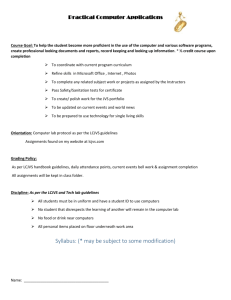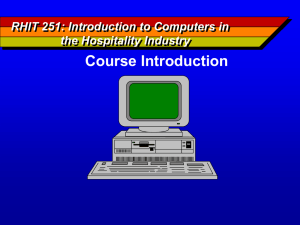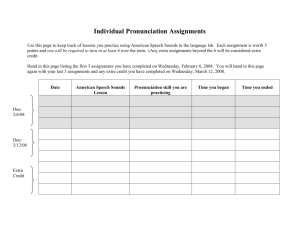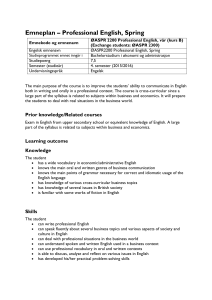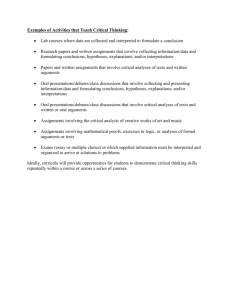Idea Paper 40 – Getting Students to Read
advertisement
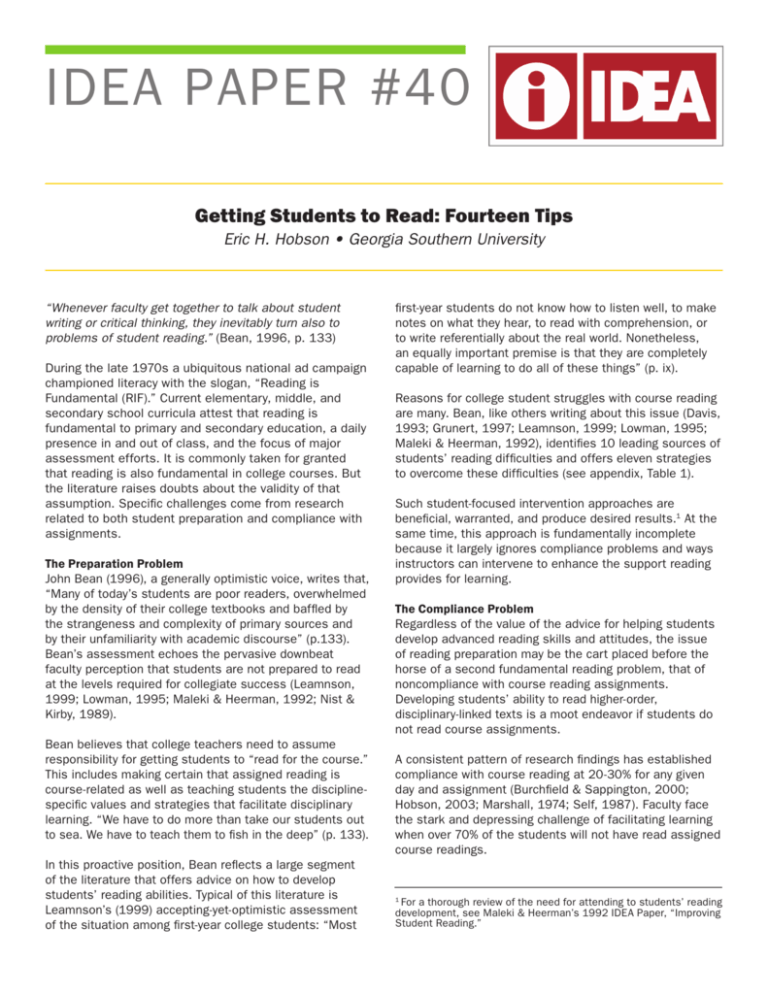
IDEA PAPER #40 Getting Students to Read: Fourteen Tips Eric H. Hobson • Georgia Southern University “Whenever faculty get together to talk about student writing or critical thinking, they inevitably turn also to problems of student reading.” (Bean, 1996, p. 133) During the late 1970s a ubiquitous national ad campaign championed literacy with the slogan, “Reading is Fundamental (RIF).” Current elementary, middle, and secondary school curricula attest that reading is fundamental to primary and secondary education, a daily presence in and out of class, and the focus of major assessment efforts. It is commonly taken for granted that reading is also fundamental in college courses. But the literature raises doubts about the validity of that assumption. Specific challenges come from research related to both student preparation and compliance with assignments. The Preparation Problem John Bean (1996), a generally optimistic voice, writes that, “Many of today’s students are poor readers, overwhelmed by the density of their college textbooks and baffled by the strangeness and complexity of primary sources and by their unfamiliarity with academic discourse” (p.133). Bean’s assessment echoes the pervasive downbeat faculty perception that students are not prepared to read at the levels required for collegiate success (Leamnson, 1999; Lowman, 1995; Maleki & Heerman, 1992; Nist & Kirby, 1989). Bean believes that college teachers need to assume responsibility for getting students to “read for the course.” This includes making certain that assigned reading is course-related as well as teaching students the disciplinespecific values and strategies that facilitate disciplinary learning. “We have to do more than take our students out to sea. We have to teach them to fish in the deep” (p. 133). In this proactive position, Bean reflects a large segment of the literature that offers advice on how to develop students’ reading abilities. Typical of this literature is Leamnson’s (1999) accepting-yet-optimistic assessment of the situation among first-year college students: “Most first-year students do not know how to listen well, to make notes on what they hear, to read with comprehension, or to write referentially about the real world. Nonetheless, an equally important premise is that they are completely capable of learning to do all of these things” (p. ix). Reasons for college student struggles with course reading are many. Bean, like others writing about this issue (Davis, 1993; Grunert, 1997; Leamnson, 1999; Lowman, 1995; Maleki & Heerman, 1992), identifies 10 leading sources of students’ reading difficulties and offers eleven strategies to overcome these difficulties (see appendix, Table 1). Such student-focused intervention approaches are beneficial, warranted, and produce desired results.1 At the same time, this approach is fundamentally incomplete because it largely ignores compliance problems and ways instructors can intervene to enhance the support reading provides for learning. The Compliance Problem Regardless of the value of the advice for helping students develop advanced reading skills and attitudes, the issue of reading preparation may be the cart placed before the horse of a second fundamental reading problem, that of noncompliance with course reading assignments. Developing students’ ability to read higher-order, disciplinary-linked texts is a moot endeavor if students do not read course assignments. A consistent pattern of research findings has established compliance with course reading at 20-30% for any given day and assignment (Burchfield & Sappington, 2000; Hobson, 2003; Marshall, 1974; Self, 1987). Faculty face the stark and depressing challenge of facilitating learning when over 70% of the students will not have read assigned course readings. 1 For a thorough review of the need for attending to students’ reading development, see Maleki & Heerman’s 1992 IDEA Paper, “Improving Student Reading.” Surveys show that students see a weak relationship between course reading and academic success. Student perception and linked behavior collected in the National Survey of Student Engagement (2001) for example, underscores the extent to which students relegate course reading to the margins of necessary activity; most college students reported that they do not read course assignments. These results are substantiated by studies that do not rely on self-report. Burchfield and Sappington (2000) found, “On average, about a third of the students will have completed their text assignment on any given day” (p. 59), a compliance rate that has been stable for 30 years (Marshall, 1974; Self, 1987; McDougall & Cordiero, 1993; Hobson, 2003). The assumption that all college courses have course texts is so ingrained that college faculty members rarely question it. One of postsecondary education’s rarest sightings is a course with neither a textbook nor a reading packet. Gatekeepers in the academic community, such as curriculum committee members, look askance at course proposals that deviate from the norm and pressure faculty to add textbooks before proposals proceed through the approval process. Other academic agents, such as faculty developers and master teachers, reinforce acceptance of this assumption when they present textbooks and reading packets as part of a complete college-level class, de facto (Altman & Cashin, 1992; Grunert, 1997; Nilson, 1998). Course structure and faculty preconceptions about students affect reading compliance. Course-based characteristics that reduce the likelihood that students will comply with reading include: no justification in the course syllabus for reading selections (Grunert, 1997), little to no differentiation between reading that is actually required to succeed in the course and reading material labeled “required” (Hobson, 2003), and a mismatch between course text literacy levels and students’ reading abilities (Bean, 1996; Leamnson, 1999). At the same time, most college teachers can name courses they have taken or taught where the course text(s) added little, if anything, to the learning process. Although these texts were identified as “required reading,” reading them was not necessary to succeed in the course. Ingrained truth is rarely challenged even in the face of discordant evidence. And so, across colleges and universities, course texts are linked to college classes not primarily because of their “added value,” but because their absence seems to violate a condition accepted as fundamental for collegelevel learning (Lowman, 1995). Most solutions for improving reading compliance offered in the literature, while helpful in specific instances, fall short because they focus only on student-based issues. Many non-student issues are important contributors to the problem of low reading compliance among college students. Multidimensional solutions are needed. The most promising approaches are those that examine and modify attitudes and activities on both sides of the teachinglearning coin. It is equally essential to: a) identify weaknesses at the institutional and course level and develop useful strategies to mitigate them. b)identify student traits that contribute to the less-thanfundamental role that reading appears to hold in college success. This paper is focused on the first of these. Before offering specific ideas for improving the value of reading assignments, it suggests that a thorough review be made of the teaching-learning situation. Reviewing Courses to Guide Strategies for Increasing the Value of Reading Assess Assumptions Teachers construct courses and activities using tacit beliefs that may or may not correspond to classroom reality or contribute to intended educational goals. Two reading-related issues — the assumed inevitability of course texts, and the weak correlation between student reading activity and course success — illustrate the influence that unexamined assumptions exert on college teachers’ instruction. Page 2 Nist and Kirby (1989) identified a pressing need is “to more closely examine...professorial demands to determine how much text interaction is necessary to be academically successful” (p. 336). This inquiry must consider such issues as: faculty and student definitions of “academic success”; “more is better” as a guiding maxim for reading’s place in college courses; and investment/return rates for course-related reading. Each of these issues is more fully discussed under the rubrics “assess the course” and “assess the audience.” Assess the Course Reassessing course assumptions should lead to a more focused assessment of students’ need to read for the course. The best courses are crafted to fit within a real context, peopled by real and diverse teachers and students working together to achieve specific educational goals (Fink, 2003). In these courses, careful attention has been paid to goals and how these are expressed directly and indirectly (Fink, 2003; Lowman, 1995). A useful way to begin the process of assessing reading’s role in college courses is to consider afresh course outcomes (Fink, 2003; Lowman, 1995). Courses serve diverse purposes. Some are introductory, serve one or several majors, meet distribution requirements or specialized interests, develop specific abilities, or have endpoints that vary from the most basic to the highly particular. Expected educational outcomes provide one criterion for determining course-related texts, reading load, and pragmatic reading compliance expectations (Lowman, 1995). Reading material must also align with the course’s main topics and its student demographics. Too many textbooks used in college courses are not appropriate to the context in which they are used. Two types of mismatch are typical; Maleki and Heerman (1992) comment on the first of these: On the surface, the ‘reading problem’ is a mismatch between college students’ reading ability and the difficulty level of their textbooks and other readings. Reading achievement of college freshmen has been declining since 1965, while college textbooks have become more difficult to read. (p. 1) Second, books are often used for purposes for which they were never intended. Reference books are often put into the hands of disciplinary novices as primary course teaching and learning tools. Doing so ignores the fact that these books are designed for highly specialized and skilled audiences (Bean, 1996; Leamnson, 1999; Maleki & Heerman, 1992). In assessing the course, it is desirable to focus attention on the meaning of “required reading.” Presumably, the term indicates that the reading contains information essential to achieving the course’s educational outcomes. The inference is that students must read every “required” item in order to achieve an acceptable level of success. Research on student reading compliance demonstrates that “required reading” is not an accurate predictor of course grades. Nist and Kirby (1989) wrote that documented reading assignment compliance rates among college students (20 to 30%) “could be partly due to the fact that students quickly discovered that they did not need to read and study their texts in order to do well in the class. Perhaps attending class and studying lecture notes were sufficient for acceptable performance” (p. 327). A common problem is that instructors tend to lump all course-linked reading assignments under the “required” heading, regardless of how central the reading assignment is to course success. This presents students with several choices about time management and calculated investment of their effort. Undergraduate and graduate students can expect a cumulative course reading load that is equal to or greater than the hours unencumbered by class meetings, recommended sleep patterns, and meals (Lang & Gore, 1988). Faced with unrealistic work loads, students turn into consummate pragmatists, determining the minimum reading investment that will produce desired course accomplishment (Lowman, 1995). When average students conduct basic cost-benefits analyses (i.e., “How much does my reading affect my course grade?”), first-, second-, and third-hand reports typically suggest a low benefit yield. Their conclusion that grades are not necessarily enhanced by faithful compliance with reading assignments has been supported by methodologically sound research (Hobson, 2003; Self, 1987). When pressed, faculty will admit that a range of “requiredness” exists among course-linked texts. The usual culprit behind the blanket use of the label “required reading” is either eleventh-hour course/syllabus preparation or the tacit assumption that college courses must have required reading. Several solutions are available, starting with a triage process designed to allocate course-linked reading material according to its potential to benefit students. This process assesses all course-linked reading materials and assigns a rating to each item according to its relevance to success in the course (e.g., “absolutely essential,” “good supporting material,” “exotic,” “appealing to experts,” “idiosyncratic choice”). Categorizing is done with the understanding that only those materials rated “absolutely essential” become “required reading” in the course. This is reading material for which students will be held accountable. When carried out objectively, this triage process renders course “required reading” loads more manageable. From the student perspective, a more manageable reading load, combined with accountability for completing reading assignments, makes reading compliance a course-related investment with high returns. When carried out periodically, the process also keeps “reading load creep” in check. Assess the Audience Unlike faculty, students are not topic experts, nor have they dedicated large portions of their adult life to the study of specific issues within discrete disciplines. Their academic purposes are more limited and their needs more confined than are those of the faculty. As experts, college teachers all too often fall into the trap of expertise: experts forget that they are aberrant in relation to the norm (Tiberius, Smith, & Waisman, 1998). Therefore, most college faculty members find it hard to imagine that students won’t read every course assignment. This misreading of normative levels of student ability, motivation, and commitment leads faculty into several erroneous assumptions. (1) Robert Leamnson (1999) argues persuasively in Thinking About Teaching: Developing Habits of Learning with First-Year College and University Students that faculty beliefs about the role of reading and writing abilities are out of synch with their students’ beliefs and experiences (see also Bean, 1996; Lowman, 1995). “A teacher can enter the classroom,” Leamnson writes, “with severely misplaced expectations. Having spent many years in a highly literate environment, we tend to take a similar level of literacy in our students as a given. Many of them, on the other hand, have gotten along reasonably well without getting too entangled with the subtleties of the written word” (p. 31). (2) College teachers do not understand the many issues that contribute to the problem of reading non-compliance. As Maleki and Heerman (1992) explain, “Most college Page 3 teachers — content specialists — are not aware that their students have trouble reading and comprehending their assigned textbooks. This is partly due to students’ weak reading abilities and partly due to difficult textbook structure” (p. 5). Faculty members need to acknowledge and understand that almost any college student cohort includes readers who are skilled, marginally-skilled, and unskilled. Skilled readers actively engage the text while those who are less skilled are passive readers. Although both skilled and marginally-skilled readers are proficient in reading the text aloud — this is a simple task — they differ in their comprehension of text because of the way they approach reading...Meaning can only be found in the head of the reader. Thus, readers bring meaning to the spoken or written word by applying their prior knowledge to it. Unskilled readers get stuck at the surface level, struggling with individual words, trying to decode letters and sounds, while skilled readers go to the deep structure and find meaning between and beyond the lines of text. (Maleki & Heerman, 1996, p. 2) (3) Facing the full range of student reading abilities is a daunting challenge for teachers who do not see themselves as equipped or charged with developing the reading abilities and endpoint-focus necessary for academic success. But when reading becomes a focus emphasized in the course structure and across course activities, helping students improve their reading skills should be the responsibility of every college-level teacher. Leamnson assures college teachers that the task is worth undertaking, but requires a long-term commitment: “The language use teachers expect, and far too often take for granted, must in fact be developed through concentration and practice” (Leamnson, 1999, p. 28). Improvement and Implementation Strategies College teachers can reduce their own and students’ frustration about course-based reading if they will consider students’ full range of educational needs and expectations as they make decisions about course structure (Lowman, 1995). Several recommendations about how best to incorporate reading into college courses have been made implicitly throughout this paper; more explicit articulation is provided in this section. Tip 1: Not every course is served by requiring a textbook Consider not having a required textbook if: • course structure duplicates text material (i.e., in-class lecture and/or discussion primarily “covers” basic material found in the textbook). • no available text offers a good fit with the course. Instead, use custom publishing options to create a course reading packet tailored to the course. • no textbook earns a triage score of “absolutely essential.” Use “Recommended Reading” lists with multiple copies of materials placed on library reserve. Page 4 Tip 2: “Less is more” applies to course reading A triaged reading list should contain fewer, carefully chosen selections, thereby reducing student perception of a Herculean workload (Lowman, 1995). Each of the remaining texts/reading assignments should connect obviously to the course: they should show up as part of in-class presentations, factor into course projects, or appear on examinations. Connections as obvious as these offer students an indisputable higher yield on their reading investment, thus increasing the likelihood that students will attempt the course reading assignments (Grunert, 1997; Maleki & Heerman, 1992), a necessary first step for deriving intended benefits from the assignment (McDougall & Cordiero, 1993). Tip 3: Aim reading material at “marginally-skilled” students Assess reading material to determine the level of reading skill students need in order to read the text in a manner and for the ends that the instructor has intended.2 A text included in the course readings primarily for entertainment purposes, for example, will require a less-strong set of student reading skills than will a text included for content purposes. Choosing reading material beyond the cognitive reach of the majority of enrolled students is unfair3 since it sets up an unequal learning environment tilted in favor of highly-skilled readers. It also invites dwindling levels of course-related reading compliance. Students will determine early on that further struggle to read “unreadable” assignments is not a warranted use of their study time (Lowman, 1995). Use Course Structure to Encourage Reading The anecdotal literature on college student reading skills development offers other recommendations that can be adapted to foster the course structural and student motivational context needed to increase student reading compliance. Among the most useful are strategies that: 1)help students understand course design choices, and related performance expectations 2) shape the in-class experience to encourage reading as a learning tool 3) develop needed course-relevant reading skills and attitudes Tip 4: Use syllabus as a teaching tool At their best, strong course syllabi can affect student compliance with course reading assignments. Effective syllabi do more than identify required reading materials; they provide background about the materials so that students understand why the reading assignments contribute to learning and how they relate to other course content and course activities (Grunert, 1997; Maleki & Heerman, 1992). See Maleki and Heerman (1992) for a useful, basic review of tools for determining a text’s reading level. 3 This tip does not advocate for “dumbing down” college courses. Rather, it argues the fairness of choosing materials that are most appropriate for the primary user — college students. 2 The syllabus is viewed increasingly as an important teaching tool (Grunert 1997; Nilson, 1998), one that can help to shift the classroom’s focus from teaching-centered to learningcentered. Students can find this shift difficult because, as Diamond (1997) points out, “Accepting responsibility for their own learning can be difficult for students who have been educated, as most have, as passive listeners” (p. ix). The passivity that marks students’ pre-collegiate academic experience is at odds with the faculty expectation that college students will engage actively in their learning. This expectation supports the inclusion of out-of-class reading as a central course component. The course syllabus can help students match their course-related activity to faculty expectations from the start. Grunert writes: Your syllabus represents a significant point of interaction, often the first, between you and your students. If thoughtfully prepared, your syllabus will demonstrate the interplay of your understanding of students’ needs and interests; your beliefs and assumptions about the nature of learning and education; and your values and interests concerning course content and structure. (p. xi) Tip 5: Explain reading assignments’ relevance Explaining the reading assignment’s relevance to the course topic and to the way that the course is structured is an investment worth making in the course syllabus and at strategic points within the term (Grunert, 1997; Lowman, 1995). This explanation is important to novices because they are not adept at making inferential connections between items that are seemingly dissimilar or only loosely related (Tiberius, Smith, & Waisman, 1998). Making the implicit explicit helps those students who need the most assistance in reading and comprehending course materials, particularly marginally skilled and unskilled readers (Maleki & Heerman, 1992). The more connective the web between course reading and course learning goals, the more likely students are to see the course’s reading assignments as relevant and worthwhile (Lowman, 1995; Cannon & Newble, 2000). Novices to higher education in general and to an academic discipline, specifically, need the scaffolding provided by explanations that relates reading to the course and the achievement of success in it (Tiberius, Smith, & Waisman, 1998; Leamnson, 1999; Bean, 1996). This reading agenda must be formally established by the course instructor through the mix of assignments placed at appropriate points within the term. Equally important, this agenda must be accepted by the student if the intended learning is to occur. Therefore, the more frequently students encounter explanations of reading-to-learning connections, the better. The course syllabus is the obvious point of first contact for persuading students that reading course assignments will be beneficial. The same opportunity should be available throughout the academic term whenever students prepare to interact with new courselinked texts (Cannon & Newble, 2000). Tip 6: Assign reading close to use date Providing students a rationale for assigning texts as they encounter new topics affects student reading compliance by highlighting the correspondence between the reading assignment and a meaningful part of the course. This timing decision closes several gaps that often limit the effectiveness of reading assignments: none-too-precise Day 1 overview statements combined with overlyfocused day-to-day course activity; differences between perceptions about teacher-based and student-based activities; abstract course elements, such as goals and outcomes, and ever-present demands like class meeting topics and assignments. Bridging gaps such as these affects student behavior, particularly with regard to student reading compliance. Although mapping all course reading assignments in the syllabus provides an overall view of the course workload, several studies have found that such a presentation can contribute to non-compliance with reading assignments (Marshall, 1974; Hobson, 2003). When these assignments are made close to the “use date” — the class session during which the information contained in that reading appears — students are more likely to read the assignments (Marshall, 1974; Davis, 1993; Lowman, 1995). Marshall (1974) found that the temporal point during the term when reading assignments were made was a significant factor in predicting compliance. In this study, for students who were given reading assignments at the start of the term, documented “use was concentrated just prior to either the mid-term or end-of-term examinations. In fact, the end-of-term checkouts reached a maximum during the examination week. On the other hand, when short but frequent lists were assigned, use was dispersed quite evenly over weekly periods as well as over the whole term” (p, 455). Hobson (2003) found similar differences between student groups assigned required reading at the start of the term and those assigned reading within two weeks of the material’s use in class. Shape Class Activity to Encourage Reading The way reading assignments are linked to class activity affects the number of students who will complete the assignments. Too frequently college faculty adopt what Lowman (1995) refers to as a “laissez-faire approach” to reading assignments — they “simply announce assigned chapters, problem sets, or papers in the syllabus and rarely mention them again” (p. 229). As Lowman points out, this approach has detrimental effects: “though requiring less effort and responsibility on the part of the instructor, [the laissez-faire approach] sets up many students to achieve far less in a class than they would have done under more engaging and sophisticated instructor leadership” (p. 230). Many strategies are available to change this situation and increase the likelihood that students will complete reading assignments.4 For more complete suggestions on ways to link reading to class activity, see Bean (1996) pp. 133-148, Davis (1993) pp. 199-201, and “When they don’t do the reading” (1989). 4 Page 5 Tip 7: Preview the reading Many texts used in college courses intimidate students because of their organizational complexity, length, foreign vocabulary, and expectations about readers’ background (Bean, 1996; Maleki & Heerman, 1992). Students can be helped “into the text” when faculty make the assigned reading material part of the in-class activity. In his extensive review of the literature focusing on student motivation to learn, Lowman (1995) concluded that, “Integrating readings into class presentations and discussions is the best means of motivating students to read beforehand — not out of anxiety at the prospect of receiving a low grade on a pop quiz, but in response to the encouragement of an instructor who gives them both an intellectual reason and the freedom to fulfill the assignment” (p. 235). Previewing course reading to increase student reading compliance can be accomplished in several ways. At the most basic level, the mention of specific readings during a class presentation will increase the likelihood that students will read that work. As Marshall (1974) found, although “few students even bother to use most of the material at all... those items given preference in the lectures are well used” (p. 456). Bean (1996), Davis (1993), and Cannon and Newble (2000) also recommend allocating time during inclass lectures and discussions to tell students something about upcoming reading assignments in order to pique their interest. Because students often wonder why faculty consider reading assignments important, they will listen carefully to brief comments about why a reading assignment is interesting and connected to prior and future issues. Tip 8: U se class activities that increase compliance and effectiveness A number of active and collaborative learning strategies receive frequent praise for their utility in encouraging students to read course material. Included among those activities are the following: •Reading Guides: Summarize important concepts found in assigned reading and identify areas where students may find the going tough. Useful items to include in a reading guide are such things as help with technical vocabulary, explanation of background concepts and cultural values that the author expects readers to be aware of, and suggestions for making the most out of illustrations, charts, graphs, and tables in the text. •Study questions: Provided in class or via a course webpage, questions keyed to key points in the required reading can increase the numbers of students who read course material. However, the technique has a drawback in that students may use these questions as last-minute test preparation material, not as guides to help their “real-time” understanding of concepts. •Short writing assignments: Ask students to explore in writing links between reading assigned for a class meeting and the topic(s) that will be addressed during the current class period (or, that were the focus of a preceding class meeting). Page 6 Tip 9: Use class time Allow in-class time (approximately 15 minutes) for students to read material that is “high priority,” particularly if that material will form the core of the class presentation or activities that follow. Tip 10: Require prior reading One reason that faculty assign course-based reading is so that students will, hopefully, be prepared and want to participate in subsequent class activity and discussions. Reading compliance is necessary to achieving this outcome, because as Burchfield and Sappington (2000) found, “failure to read assignments is a strong predictor of nonparticipation” (p. 58). To combat low reading compliance levels among students, McDougall and Cordeiro (1993) advocate the use of random questioning because relying on students to volunteer to participate in class discussion and activity “actually reinforces the ‘nonpreparation’ behavior of students who fail to volunteer” (p. 41). McDougall and Cordeiro (1993) acknowledge that random questioning will strike many faculty members as heavyhanded and many students as mean. Yet, they argue that the method’s benefits carry the day: ...potential or actual discomfort with the procedure should be minimized as students and instructors alike begin to reap the personal benefits of consistent preparation for lecture and discussion, including: (a) increased engagement, understanding, and participation; (b) more consistent coverage of assigned readings and course objectives; (c) decreased reliance on timehonored traditions such as cramming for exams or reading assignments only after lecture and discussion have occurred; and (d) improved short- and long-term academic outcomes. (p. 48) Tip 11: Test over reading material Testing students over material contained in assigned reading, and, in particular testing students over reading assignments not covered in class, is the most punitive of strategies presented here to increase student compliance with course reading. The rationale supporting such testing comes from faculty with different perspectives. On the pragmatic side, McDougall and Cordeiro (1993) argue that “many students simply do not complete assigned readings punctually or effectively in the absence of periodic verification or impending grade-contingent tasks” (p. 47). Although he advocates classroom activities that motivate students to read without the threat of a test, even Lowman (1995) acknowledges that including test questions over required reading that is not the focus of in-class presentation or discussion can induce some students to read material that they would not read otherwise. Develop Needed Reading Skills and Attitudes To be effective classroom teachers, it is often necessary to be also an effective teacher of reading skills and attitudes. Tip 12: Teach reading strategies overtly Any teacher who includes reading assignments in a course should also ensure that students have the reading tools they need to use that material for the purposes intended. To read course material at the level of adroitness that faculty desire, students will need to be taught how to do so. Even skills that seem basic to faculty warrant direct instruction, including such a simple skill as marking texts. Nist and Kirby (1989) explain why text marking offers a useful starting point for developing students’ reading skills: “Text marking is generally ignored [in secondary education] because high school students are not permitted to mark their books. Yet it is assumed that college freshmen should be able to make the transition to text marking by the sheer fact that they are college students” (p. 336). Providing students with suggestions about how to mark texts that work particularly well in specific content areas does not have to be a big burden, nor does it need to entail onerous preparation. A good place to start is to reproduce several pages from the course textbook that are marked in a manner that can aid learning. Even better is to provide annotation of the marking that explains the strategy used and the choice made to determine what was marked and what was not. Such modeling serves two purposes: 1) it brings reading material into class as an object of in-class discussion, and in doing so legitimates the textbook (or other reading materials) and 2) it provides a model of how experts approach material presented in complex structures, including making sense of technical language, shuttling between text and supporting materials, cross-referencing topics via the text’s index, and using study guides for formative assessment purposes. Such in-class (or out-of-class modeling via a course website) instruction should occur early in the term. As Nist and Kirby’s study of student text marking strategies revealed “while students tend to develop marking patterns and consistently utilize these patterns as they mark text, students, overall, fail to effectively mark texts.” The lack of marking skill is often due to the absence of an effective guiding rationale. Nist and Kirby (1989) found that the material that students ...most often marked was factual material of a nonconceptual nature or random information that probably should not have been marked in the first place. Students seemed to have a difficult time in selecting and marking key ideas in spite of the fact that publishers include numerous cues and textual aids supposedly included to help students...Students ignored these aids (p. 335). It is never too early to help students tell the forest from the trees. And, given the difficulty of learning to deal effectively with academic prose, such assistance cannot be offered too often. Follow Up Teachers can set the expectation that reading compliance is essential for a course in many ways, including the strategies described above. However, students will need on-going, organized reinforcement if they are to accept that expectation. Paying regular attention to reading compliance is important because of the norming influence that such attention triggers (Burchfield & Sappington, 2000). Tip 13: U se Classroom Assessment Techniques (CATs) to assess compliance The cost of not monitoring compliance is marked. Burchfield and Sappington (2000) predict several undesirable results: Failure to monitor reading compliance sends a message to students that this aspect of learning is optional and of little concern to the instructor. In that sort of climate, it would not be surprising that students would postpone reading until a pending exam made it a practical necessity. Also, the unprepared student is more likely to adopt the role of silent, uninvolved observer than is the prepared student.” (p. 59) A number of classroom assessment techniques (CATs) (Angelo & Cross, 1993) can provide teachers with an accurate picture of student compliance with assigned reading. One approach is simple: periodically askstudents to anonymously report if they have completed reading assignments for a given class period (McDougall & Cordiero, 1993). Burchfield and Sappington (2000) routinely include the question, “I read my entire assignment for today, true or false,” on class quizzes (p. 59). Angelo and Cross (1993) present 50 CATs that offer myriad approaches to assessing the state of student reading compliance. CATs can provide teachers with important insight into the beliefs that students have about course-linked reading and the rationale(s) used as they choose to read/not read for class. Tip 14: Get assistance where/when needed Few college teachers are trained to teach reading. It behooves them to become familiar with specialists who staff campus reading programs. Maleki and Heerman’s IDEA paper, “Improving Student Reading” (1992), offers a good introduction to the ways in which college faculty can collaborate with such student support services both to help individual students develop needed reading skills and to shape a campus culture that values reading as part of a mature learning process. Conclusion Changing the academic landscape so that most students read most course assignments most of the time is a complex challenge. The complexity lies in the fact that when college faculty members state that they want students to be better readers, they are being somewhat misleading in articulating their concern. Leamnson (1999) unpacks their embedded meaning by pointing out “What can be developed, given good teaching, energy, and some Page 7 luck, is not so much a skill in thinking, but the habit of thinking...The ability to do a thing is different from the inclination to do it routinely, out of habit” (p. 29). It is precisely the “reading habit” that the RIF literacy push advocated and that college faculty believe is fundamental to academic success. The goal implicit in faculty members’ commitment to reading as fundamental to college-level learning is one of acculturation: instructors want their students to come to a place where, like the faculty member, they internalize (make tacit) a commitment to reading as one of the essential tools necessary for higherorder thought, rational action, and fulfillment. Helping Eric Hobson is the Director of The Excellence in Teaching Center at Georgia Southern University. He has lectured extensively on such topics as active learning, assessment, Page 8 students get to this point, however, is a process that takes time, during which direct instruction and continuous modeling by faculty members and student maturation must occur. If they choose, college teachers can affect the first two items in this list directly, while affecting the trajectory of the latter item more indirectly. If high levels of student reading compliance and, by extension, high levels of reading comprehension, are endpoints that truly matter, faculty must accept their role in an inter-dependent process; they are the key agents in making reading fundamental in college. and the scholarship of teaching. He may be reached by email at ehobson@georgiasouthern.edu. References Altman, H.B. & Cashin, W.E. (1992). Writing a Syllabus. IDEA Paper No. 27, Manhattan, KS: Kansas State University, Center for Faculty Evaluation and Development. Angelo, T.A. & Cross, K.P. (1993). Classroom Assessment Techniques: A Handbook for College Teachers (2nd ed.). San Francisco: Jossey-Bass. Bean, J.C. (1996). Engaging Ideas: The Professor’s Guide to Integrating Writing, Critical Thinking, and Active Learning in the Classroom. San Francisco: Jossey-Bass. Burchfield, C.M. & Sappinton, J. (2000). Compliance with required reading assignments. Teaching of Psychology, 27(1), 58-60. Cannon, R. & Newble, D. (2000). A Handbook for Teachers in Universities and Colleges: A Guide to Improving Teaching Methods (4th ed.). London: Kogan Page. Davis, B.G. (1993). Tools for Teaching. San Francisco: Jossey-Bass. Diamond, R.M. (1997). Foreword. In J. Grunert, The Course Syllabus: A Learning-Centered Approach (pp.viii-x). Bolton, MA: Anker. Fink, D.L. (2003). Creating Significant Learning Experiences: An Integrated Approach to Designing College Courses. San Francisco: Jossey-Bass. Grunert, J. (1997). The Course Syllabus: A Learning-Centered Approach. Bolton, MA: Anker. Hobson, E.H. (2003, November). Encouraging students to read required course material. Workshop presented at the 28th Annual Conference of the Professional and Organizational Development (POD) Network in Higher Education, Denver, CO. Lang, F. & Gore, T.A. (1988). A study of the reading habits of fourth-year medical students. Journal of Medical Education, 63, 567-568. Leamnson, R.N. (1999). Thinking About Teaching: Developing Habits of Learning with First Year College and University Students. Sterling, VA: Stylus. Lowman, J. (1995). Mastering the Techniques of Teaching (2nd ed.). San Francisco: Jossey-Bass. Maleki, R.B. & Heerman, C.E. (1992). Improving student reading. IDEA Paper No. 26, Manhattan, KS: Kansas State University, Center for Faculty Evaluation and Development. Marshall, P. (1974). How much, how often? College and Research Libraries, 35(6), 453-456. McDougall, D. & Cordiero, P. (1993). Effects of random-questioning expectations on community college students’ preparedness for lecture and discussion. Community College Journal of Research and Practice, 17, 39-49. National Survey of Student Engagement. (2001). Bloomington, IN: Indiana University. Nilson, L.B. (1998). Teaching at Its Best: A Research-based Resource for College Instructors. Bolton, MA: Anker. Page 9 References continued Nist, S.L. & Kirby, K. (1989). The text marking patterns of college students. Reading Psychology: An International Quarterly, 10, 321-338. Self, J. (1987). Reserve Readings and Student Grades: Analysis of a Case Study. Library & Information Science Research, 9(1), 29-40. Tiberius, R.G., Smith, R.A., & Waisman, Z. (1998). Implications of the nature of “expertise” for teaching and faculty development. In M. Kaplan (Ed.), To Improve the Academy, 17, 123-138. Stillwater, OK: New Forums Press and the Professional and Organizational Development Network in Higher Education. T: 800.255.2757 T: 785.320.2400 F: 785.320.2424 E: info@theideacenter.org www.theideacenter.org ©2004 The IDEA Center Manhattan, Kansas When they don’t do the reading. Teaching Professor, 1989, 3(10), 3-4. APPENDIX Table 1: Bean’s Student Reading Problem/Solution List Sources of students’ reading difficulties 1. Misunderstand the reading process 2. Fail to adjust reading strategies for different purposes 3. Struggle to perceive an argument’s structure as they read 4. Struggle to assimilate the unfamiliar 5. Struggle to appreciate text’s rhetorical context 6. Struggle to see themselves conversing with the author 7. Lack “cultural literacy” assumed by the text’s author 8. Lack adequate vocabulary 9. Struggle to track complex syntax 10. Struggle to adjust reading strategies to the varieties of academic discourse (Bean, p. 134-37) Page 10 Strategies to help students become better readers 1. Explain how your reading process varies with your purpose 2.Show students your note-taking and responding process when you read 3. Help students get in the dictionary habit 4. Teach students how to write “What it says” and “What it does” statements 5. Make students responsible for texts not covered in class 6. Awaken student interest in upcoming reading 7. Show that all texts reflect the author’s frame of reference and warrant questioning and analysis 8. Show students the importance of knowing cultural codes for comprehending a text 9. Create “reading guides” for particularly difficult texts or for texts with unfamiliar cultural codes 10. Help students see that all texts are trying to change their view of something 11. Teach students to play the “believing and doubting game” (Bean, p. 137-43)

